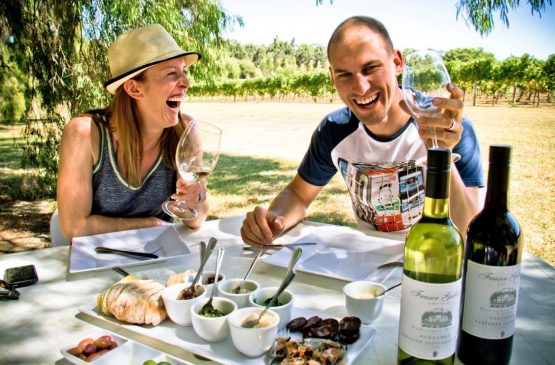It would be fair to say that the recent January weather has been much warmer than what could be normally expected out in the vineyards in Margaret River. January 2012 has been the warmest on record and the warm night time temperatures haven’t provided a great deal of relief from the sweltering heat.
Working out in the vines has proven to be a challenge and many of us have opted for early starts and a long break during the middle of the day… then working a few hours into the evening to beat the heat. The vines are responding favourably to the warmth and we have been sampling grapes much earlier than normal to establish the optimum ripeness for each variety.
Chardonnay is the earliest ripening variety that I work with and we started harvest on some first cropping vines on the 29th January. This is by far the earliest harvest date that we can remember in Margaret River wine region…. as usually we would start harvest in the middle of February. The fruit harvested to date has been excellent quality, with ripe seeds, great flavour intensity and the winemakers appear happy. The sugars in relationship to berry physiologic ripeness have been lower than normal and this will result in slightly less alcohol being present in finished wines… but with great flavour intensity and refreshing natural acid being present.
At this early point we consider that 2012 will be recognised as a great vintage. Generally we can use the time taken from veraison (berry softening) to harvest as an indicator of wine quality… the shorter the time taken to ripen, the better the quality in white wines. Bring on the 2012 vintage we say!!
Sampling of grapes prior to harvest is done to determine the sugar and acid levels found in the juice. This analysis gives the winemaker an appreciation for the potential natural sugar conversion to alcohol and also for the balance of acidity within the finished wine…. important attributes for mouth feel and also preserving the wine. Representative random sampling of bunches (usually 20 bunches are collected for a sample) is conducted along rows within blocks of vines and bunches are taken to the winery or laboratory for crushing and de-juicing. The juice samples are analysed and then the data is recorded and graphed to show trends throughout maturity. Tasting the juice samples will give indication of the fruit flavour, intensity and other attributes that may give further indication for the suitability for harvest to commence. The information is relayed to the vineyard manager and then a forecast on harvest date is made… transport and harvesting arrangements are scheduled and harvesting commences.
To a great extent, most of the grapes harvested in the early phase of vintage this year have been picked by hand. In this set of circumstances, we prefer to harvest Chardonnay with whole bunches and go straight to press to reduce extraction of phenolic hardness usually associated with crushing and then pressing (simply, it just means that by just pressing the free run juice out of berries that the finished wine has tantalizing mouth feel and makes the best quality wine….). Some of the hand harvesting is done for sparkling wine base and this requires delicate handling and cooling before processing to reduce colour extraction. We are certainly gaining a reputation for our sparkling wines from Margaret River and those that are lovers and “in the know” find the bubbles attractive (Yum!).
Hand harvesting can be a challenge, especially in hot weather and with helpers that come from all corners of the globe we have to be considerate and allow time for them to adjust to the climate and the job at hand. We are very fortunate that we have the environment that attracts travellers to Margaret River and creates the situation for employment with backpackers and travellers earning some money before moving on and roving further into the state. The recent hot spell of weather has tested the metal of a few new chums to Margaret River but the attraction of money, “all the grapes that you can eat” and the prospect of adding extra time for international working holiday visitors drives them on. After a hard day picking grapes, I’m sure a beer, a kind word and surf helps ease the pain and makes the stay in Margaret River pleasurable and memorable.
Many tourists come to Margaret River purely for the natural environment, the National Parks and Coastal attractions. We are incredibly blessed with natural biodiversity throughout the Margaret River wine region and at present we have the most spectacular Marri tree flowering in our forests. Observing the flowering we can see many buds yet to burst and therefore the promise of lots of blossom still to come. Eucalyptus Calophylla is the botanical name of what we know commonly as Marri or Red Gum and the significance of this flowering gum at harvest is flowers full of nectar are a preferred food source for the marauding silvereye birds. With the prolific blossom, the silvereyes are satiated on nectar and leave the grapes alone. In years like this when the blossom is so prolific there is little motivation to apply bird netting, a saving in labour and machine hours and making life a little easier out in the vineyard.
Contributed by Bruce Pearce, Viticulturist
About Margaret River Discovery Tours
Sean Blocksidge is the owner operator of the Margaret River Discovery Company, an avid photographer, blogger and South West WA ambassador. In 2010 he won Western Australian Guide of the Year and his tours have been rated the #1 thing to do in Australia on the Tripadvisor website for the past two years.



